Natural relief
There are a number of medicinal herbs that might be very beneficial for the prevention and relief of allergy symptoms. The following is a guide to many therapeutic plants, with simple recipes to be used every day. In addition, essential oils from A to Z, made with herbs, are for topical use and help in the treatment of allergies.
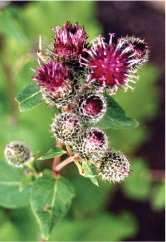
+ Fitotherapy is one of the oldest curing arts. Since ancient times cultures have used remedies extracted from natural plants, especially herbs and plants for internal use or external applications to cure the human body. This ancient folk knowledge about the curative powers of plants has been inherited today to relieve and treat a number of discomforts. The essential herbs and recipes included in the following pages are especially indicated to relieve allergy symptoms. They are natural and if used properly don't cause any harm, although it's advised before using them to consult your doctor to take advantage of the beneficial relieving powers of natural herbs.
NOTE
You should always consult your physician before starting any herbal treatment.
Burdock
(Arctium majus)
- • Parts used. The roots and leaves, to prepare in infusions or to make tinctures.
- • Belongs to the cardos family, although it's native to Europe, it can be found in China and the United States.
- • It is principally used as a blood purifier because it eliminates toxins from the body. This plant is also used to treat conditions such as psoriasis, eczema and other skin problems. The root is used for headaches, cough and sore throats.
- • Warning. This plant shouldn't be used during pregnancy.
BURDOCK ROOT TINCTURE
For skin ailments, especially eczema caused by allergy, take 20 drops of the tincture diluted in water, 2 to 3 times per day for 4 weeks.
Marigold
(Calendula officinalis)
- • Parts used. Petals and flower tops are used to prepare infusions or to make ointments, creams and lotions.
- • Native to Europe, this garden plant looks like a large yellow or orange colored daisy.
- • It is very beneficial for the treatment of many skin problems such as acne, eczema and psoriasis, and in relieving other general skin inflammations.

AGAINST SKIN ERUPTIONS
Skin eruptions as a result of allergies, infections or irritated skin, you can apply an ointment, cream or lotion with marigold directly onto the part of the skin with eruptions or rash, 2 to 4 times a day. For a lotion, prepare an infusion with 2 teaspoons of marigold flowers in 1 cup of water. Drain, let cool and apply.
ESSENTIAL OILS FROM A TO Z
ANGELICA
Earthy, sweet and penetrating aroma. When applied over the skin it helps to relieve skin eruptions and skin affections. When inhaled this oil is useful to decongesting the nose. It also helps to relieve coughs, headaches and bronchitis. Combines with geranium, grapefruit, lemon and camomile.
EUCALYPTUS
Because of its decongestive properties this oil is very effective in fighting against respiratory problems. It helps treat headaches brought on by colds and hay fever. It has a clean, potent and refreshing aroma that rejuvenates the nervous system and gives off a stimulating sensation. On the skin, it helps to cure a number of skin ailments, including herpes.
WARNING
Essential oils are for external use only, they should never be ingested. Keep stored away from children and keep away from your eyes.
Echinacea
(Echinacea spp)
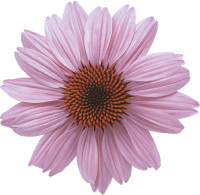
- • Parts used. The roots and rhizomes are used to prepare infusions or to make tinctures.
- • Native to North America, today it is cultivated throughout the world.
- • This plant has a number of active properties that act on the immune system. It tends to be used as a blood purifier, especially for skin problems, because it eliminates dermatological alterations such as skin eruptions, acne and eczema. Echinacea also facilitates the action of interferon, a natural chemical mediator which helps the body's healing response to viral infections such as colds and flu, herpes and hay fever.
INFLAMED BRONCHIOLES
Drink ½ teaspoon of echinacea tincture, diluted in a glass of water, 2 or 3 times a day. 2 cloves of garlic a day can accompany this internal remedy.
English ivy
(Hedera helix)
- • Parts used. The leaves and young stems.
- • This vine plant with perennial leaves, is native to moist forests in Western, Central and Southern Europe. It shouldn't be confused with poison ivy (Rhus toxicodendrum) , which is found in the Americas.
- • English ivy has a high content of saponines that help to reduce mucus in the respiratory system, this plant acts as an expectorant. It has antispasmodic properties, especially for the bronchial tubes and is a constrictive, it fights against blood clots and is an antibiotic. When used internally, it can be used for constant cough and respiratory conditions such as bronchitis and asthma. Used externally it is an analgesic and can be used to fight cellulitis, arthritis, headaches and ulcers.
- • Warning. You should never eat the fruit from this plant, because it can cause vomiting and diarrhea. It is not recommended during pregnancy. This plant can irritate sensitive skin.

TO RELIEVE COUGH
Place 2 teaspoons of dried English ivy in 1 cup and add hot water. Let sit and steep for 3 minutes. Drain and drink 3 cups a day. You can add a little honey to sweeten. You can also make this infusion adding liquorice, using the proportion of I teaspoon of English ivy to 1 teaspoon of liquorice root.
ESSENTIAL OILS FROM A TO Z
GINGER
Its spicy, intense and warm aroma soothes pains brought on by humidity, this is why it helps to reduce nasal congestion, along with a calming and stimulating effect. Combines with atlas cedar, eucalyptus, myrrh, lemon, neroli, camomile, sandalwood and vetiver.
Safety. People with sensitive skin should use ginger diluted, when using it in massages and in baths.
LAVENDER
Ideal for fighting bronchial problems, hay fever, headaches, flu and asthma. It is also tends to be used to reduce blood pressure and prevent heart palpitations. It is an effective bug repellent, and can be used on insect bites, wounds and rashes. Blends with geranium, jasmine, lemon, camomile, rose, and pine.
Safety. Shouldn't be used during pregnancy.
Lapacho tree
(Tabebuia avellanedae)

- • Parts used. The inner bark of the lapacho tree is used to prepare decoctions and to make tinctures.
- • Native to Brazil and Argentina, it has extended to other parts of the American continent.
- • It has a direct action on the immune system and helps to fight bacterial and viral infections, especially of the ear, nose and throat. Its detoxifying power helps in treating skin problems.

ANTIALLERGIC MINT
As a decoction, drink 1 cup 3 times a day. As a tincture, drink 60 drops 3 times a day.
Mint
(Menta piperita)
- • Parts used. The leaves are used to prepare infusions and to make essential oils.
- • Native to Europe, this herb is widely used in the culinary world, and is cultivated throughout much of the world.
- • Much recommended for relieving skin eruptions, because it helps the skin to recover faster. Applied externally it has a calming effect, helping the mind and body to relax. This oil has anti-bacterial properties. It relieves coughs, colds and the flu.
- • Warning. This remedy is not recommended for children under the age of 12 (neither in infusions nor as a topical essential oil) or for mothers who are breast-feeding, because this herb may affect breast milk production. It should be avoided if you feel weak or are suffering from prolonged fevers.

NASAL CONGESTION
To relieve nasal congestion, add a pinch of mint to an infusion made with equal parts of yarrow and elderberry. This is an excellent remedy against excess mucus.
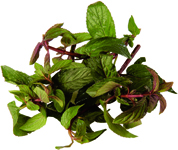
ESSENTIAL OILS FROM A TO Z
MARJORAM
Helps to relieve pressure caused by excess mucus in the chest and asthma, bronchitis and sinus infection symptoms. On the skin it improves blood circulation and comforts the skin. Combines with Atlas cedar, cypress, lavender, rosemary, palisander, ylang ylang.
Safety. When used excessively this oil can cause drowsiness. It's best to avoid using it during pregnancy and it shouldn't be used for small children.
MYRRH
This resistant and penetrating aroma with a touch of lemon, has a powerful effect on the mucous membranes, which is why it helps to decongest the lungs and respiratory system. One form of use is inhaling a few drops of myrrh on a tissue or handkerchief. Because of its calming effects, it's beneficial in stressful situations.
On the skin it has a double effect, tonic and restoring.
Evening primrose
(Oenothem biennis)

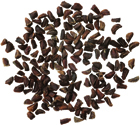
- • Parts used. Stems, leaves and seeds.
- • Native to Europe, this plant has many essential fatty acids that act as cell and inter-cell mediators. It has anti-inflammatory and antiallergenic properties.
- • The high content of tannins found in the stems and leaves gives the herb its curative properties, useful for injuries and irritations. However, the plant's most important active ingredient is found in the oils extracted from the seeds that can effectively reduce the symptoms related to skin diseases.
- • Warning. This plant shouldn't be used during the first three months of pregnancy or for people who suffer from epilepsy. The oil should be prepared by professionals and not at home.
PRECIOUS PEARLS
You can purchase primerose oil in pearls (soft - gels) of 500 mg strength. If you prefer not to swallow the capsule, you can break it and extract the oil to add to a liquid. It's recommended using for at least 8 weeks in order to see visible improvements in skin affections.

Violet
(Viola tricolor)
- • Parts used. The aerial parts of the plants are used to make infusions.
- • It is grown in Europe, North Africa and other temperate zones in Asia, and even on the American continent.
- • This is an excellent purifying herb, recommended for relieving skin conditions such as eczema and allergic problems. The infusion is a great wash for skin eruptions. Because of its expectorant properties, it is used against bronchitis and compulsive cough.
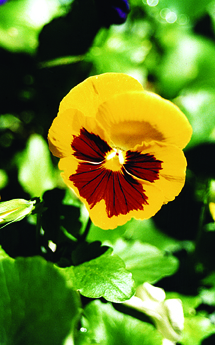

INFUSION FOR SKIN ERUPTIONS
Prepare an infusion and apply directly on the skin as a compress or soak for 5 minutes.
ESSENTIAL OILS FROM A TO Z
ROMAN CAMOMILE
This oil is especially good for hypersensitive skin, which tends to have allergic reactions to different cosmetics. It is good for the treatment of a number of physical discomforts caused by stress, such as some skin conditions. Blends with angelica, clary sage, geranium, jasmine, lavender, neroli, rose, ylang ylang.
Safety. This oil shouldn't be used in the first four months of pregnancy. In high doses it can have an hypnotic or sedative effect.
ROSEMARY
Has a strong, clean and refreshing aroma that is an effective decongestant in fighting respiratory infections and lung ailments. It also helps to revitalize and stimulate the central nervous system. It blends with Atlas cedar, myrrh, geranium, ginger, grapefruit and basil.
Safety. Don't use during pregnancy or if you suffer from epileptic attacks or for high blood pressure.
TINCTURE FOR HAY FEVER
For cases of allergies, especially hay fever, tincture made with elderberry can be useful. Take 1 teaspoon 3 times a day.
Elderberry
(Sambucus nigra)
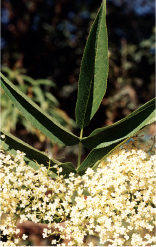
- • Parts used. Flowers, leaves and bark are used to prepare infusions and make tinctures.
- • This is a common tree in Europe.
- • The flavonoids it contains, including quercetin, are believed to account for the therapeutic effects of the elderberry flowers and berries. Thanks to these acids this plant has anti-inflammatory properties. This plant is very good for the respiratory system in general, but particularly for specific allergic reactions such as seasonal hay fever. It also has diaphoretic effects that stimulate the elimination of toxins through sweat, which is very good for colds and flu.
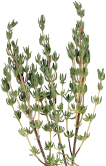
DECONGESTANT
Thyme flowers infusion can be used as a vapor inhaler to clean the nasal cavities.
Thyme
(Thymus vulgaris)
- • Parts used. The entire plant is used in infusions or to make essential oils for topical use.
- • Native to the Mediterranean. Today it's cultivated throughout the world.
- • This plant is an effective remedy for the respiratory system. It has expectorant and antiseptic therapeutic effects, which is why it's ideal for fighting respiratory infections and other respiratory problems such as asthma, hay fever, sore throats and cough. Timol, one of the plant's therapeutic components, acts as an antispasmodic and also has sedative and antiviral effects.
- • Warning. This plant shouldn't be used in excessive doses. Do not ingest the essential oil. This essential oil shouldn't be used topically during pregnancy.

FIGHTING COUGHS
Because thyme is an antiseptic for the entire respiratory system, it's recommended drinking an infusion 5 times a day. For a dry cough, it is recommended to blend it with liquorice root powder in equal parts and preparing it as an infusion. Drink ½ cup, 6 times a day. You can also mix equal parts of each tincture and take 1 teaspoon and drink up to 5 times a day, diluted in water.
ESSENTIAL OILS FROM A TO Z
SANDALWOOD
Stimulates the immune system, fights sore throat and respiratory infections. On the skin it has a regulating and anti-inflammatory effect on dry eczema. It helps to soothe rashes and scaling skin. At the same time it helps to reduce nervous tension and anxiety. Combines with bergamot, cypress, myrrh, geranium, jasmine, lavender, lemon, inciense, neroli, basil, vetiverand ylang ylang.
TEA TREE
Tea tree oil helps to strengthen the immune system. This oil may be an effective remedy against the flu and headache because of its repairing action over the respiratory system, contributing in the relief of asthma, as well as bronchitis and sinus infections. On skin, this oil can act as an antiseptic and cleaner. It helps to fight acne, herpes, insect bites and dandruff.

Comment about this article, ask questions, or add new information about this topic: